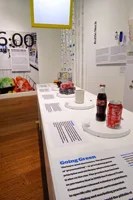 Families can get a glimpse of what living in the city might be like environmentally in the year 2030. The Museum of the City of New York’s new exhibit, “Growing and Greening New York: PlaNYC and the Future of the City,” offers a snapshot of the future, starting with changes New Yorkers need to make today.
Families can get a glimpse of what living in the city might be like environmentally in the year 2030. The Museum of the City of New York’s new exhibit, “Growing and Greening New York: PlaNYC and the Future of the City,” offers a snapshot of the future, starting with changes New Yorkers need to make today.
The exhibit walks families through a day (and night) in the life of a New Yorker — from 7am to 2am — and shows how our daily lives and activities impact the environment. This includes everything from choosing what kind of showerhead to use, to subway crowding, to the energy output from the buildings in which we work, to how the types of food, packaging, furniture and appliances we buy affect energy.
Since 70 percent of New Yorkers use public transportation to get to work, “what is unique and special about living in New York City is that that you’re using a lower carbon footprint than you do living outside the city,” says Susan Johnson, the museum’s curatorial associate. But by 2030, one million more people are expected to be living among the eight million of us already calling the five boroughs home, leading to more waste, pollution, energy consumption, traffic and subway congestion.
The exhibit includes possible environmental and public transportation solutions suggested by engineers, scientists, urban planners, architects, and others involved in the Bloomberg administration’s PlaNYC, with status updates and specific timelines. For example, by 2017, one million more trees will be planted throughout the city and new parks will be built so that by 2030, every New Yorker is expected to live within a 10-minute walk from a park. Five thousand new bike racks will be available around the city by 2011, and a 1,800-mile master bike plan will double the number of bike commuters by 2015 and triple it by 2020.
The museum has kept kids’ attention spans in mind, trying to incorporate touch-top displays and interactive features similar to what’s found in a science museum, according to Johnson. For example, there’s a touch-top screen that features various types of trees to click on, which then showcases a description and maps out exactly where they can be found in Central Park. Another device called the EnergyHub Touchscreen lets kids measure how much energy is being used from each appliance in a display of a “green” living room.
Kids will also have fun balancing on footprints set a specific distance apart, representing the current personal space between people on the subway. As the years go on, the footprints get closer and closer, demonstrating severe overcrowding. A short video, The Water Underground, uses Super Mario Brothers graphics and music to show how the city handles the billions of gallons of water flowing underneath the ground, and kids can touch a display of porous asphalt, which prevents pollution from entering surface and ground water.
“Kids are very interested in things that connect to their lives,” says Sarah Henry, the museum’s deputy director and chief curator. Since the exhibit opened in December, kids who have seen it are reporting a new understanding of everyday effects on the environment that they didn’t previously consider part of the problem or the solution. Now, “everyone’s interested in what’s under the street, inside the walls, and on the roof,” she says. For example, kids will learn that consumer buildings require 75 percent of the city’s power demands, due to light, heating, and computer needs. “Even though the buildings are there, you can’t see the impact on energy,” she explains.
Kids can view proposed solutions, like the construction of new “green” buildings, including the Bank of America Tower, which will filter air both in and back out and produce ice in the evening for daytime air conditioning. New proposed gyms will even generate light using power from treadmills, and other environmental solutions like installing green roofs will be recommended for existing buildings.
But many changes can also take place right in the home, and Henry says that kids can be the greatest advocates for change in adults. In the “evening” part of the exhibit, families learn about composting and the importance of shopping for local produce to reduce “food miles,” and examine the energy consumption of different foods and products along a countertop. They’ll also learn what types of home furniture and products to shop for. Finally, families can view environmental progress in other cities around the world and see how New York compares. The exhibit ends with another touch screen that offers a quiz to test what you’ve learned.
On display through April 22 (Earth Day). Open Tuesdays-Sundays 10am-5pm. $9; seniors/students $5; children 12 and under FREE. Families (with two adults) $20. The Museum of the City of New York, 1220 Fifth Avenue, Manhattan. 212-534-1672. www.mcny.org.






















